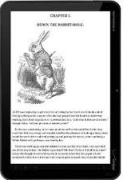Project Sunflower: XOOM Usability Study

 The Motorola XOOM is the first tablet to run on Android 3.0. It supports 720p recording and boasts an Nvidia Tegra 2 1GHz processor. The XOOM was introduced as a tablet that does a lot of things, one of which is eBook reading. Our aim was to study the eBook reading capabilities of the device. We studied the reading experience, the device itself and the UI the device had to offer from a purely eBook reading perspective.
The Motorola XOOM is the first tablet to run on Android 3.0. It supports 720p recording and boasts an Nvidia Tegra 2 1GHz processor. The XOOM was introduced as a tablet that does a lot of things, one of which is eBook reading. Our aim was to study the eBook reading capabilities of the device. We studied the reading experience, the device itself and the UI the device had to offer from a purely eBook reading perspective.
Device
The first thing noticeable about the device, or should I say not noticeable, was the power button. The power button was nowhere to be seen on the sides of the device. Users often mistook the SIM card slot for the power button. This was an issue with all users. The power button is on the back of the device, besides the camera. It isn’t easily identifiable.
The XOOM weighs 1.6 lbs, slightly more than iPad and Kindle that weigh at 1.3 lbs and 1.2 lbs respectively. This was another concern shown by users. The users pointed out that the impact of the weight was clearly evident through stress in the wrists when holding the device.
The thickness of the device is also not comparable to the iPad 2 and Kindle DX, the two other devices used for the study. The users thought a thinner device would be more convenient. The greater thickness however, did provide for slightly better grip.
The keyboard feels too broad when holding the device in landscape mode making it difficult to type.
User Interface
The users liked the eBook reading experience the app had to offer. The pages were displayed across the entire screen not wasting space at the edges and thus displaying more words per page in portrait mode. Settings provided by the app were also deemed adequate by users.
The most admired feature was ”Night mode’. This feature allows users to change the screen to white on black from black on white. This makes it more comfortable to read in low-lighting conditions and especially at night. This feature is an advantage because the backlit display can cause severe stress to the eyes when reading continuously for a long time.
The areas users generally found tricky were finding applications to read books on the device. Previous experience with the device played a significant role in this case. The users with little or no experience found it difficult to find and install apps. Most users wanted the app to be installed by default instead of requiring the user to install it.
The landscape view does not support 2-page display, causing almost 2 inches of screen space being wasted on either sides of the screen. This space could be better utilized to display more text and thus help users to see more information on the same screen.
The most severe issue was that of crashes. In case of some users, the app crashed abruptly and the user was taken back to the homescreen.
Bottomline
The Motorola XOOM is a powerful device and runs the latest Android 3.0 OS, however as far as eBook reading goes, is not a very suitable option. Especially for academic text. The device’s weight. thickness, abrupt crashes, and the ePub format’s illustrations rendering capabilities deems it unsuitable for reading academic text. Like most other tablets, the XOOM is good for leisure reading with its simple UI, various viewing modes and fast responsiveness. Academic text on the other hand requires more information displayed on a single page, the ability to flip through chunks of pages while being able to see the scrolled contents and the ability to make notes on the textbook. It will take more time till eBook readers support these features and as of now the Motorola XOOM does not seem ready for use as an academic textbook reader.

